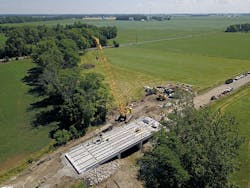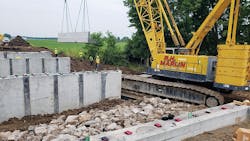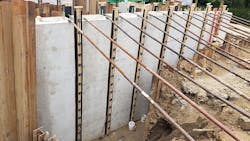Indiana DOT completes first all-precast bridge replacement using carbon nanofiber UHPC
The $40 billion allocated for bridge repairs, replacement, and rehabilitation under President Biden’s Infrastructure Investment and Jobs Act is the single-largest dedicated bridge investment since the construction of the Interstate Highway System.
To maximize the once-in-a-generation funding opportunity, departments of transportation are seeking ways to help them save time and money in addressing a backlog of projects. A recent successful bridge replacement project in Indiana could offer insights.
The project replaced a three-span continuous reinforced concrete slab bridge built in 1955 with a three-span continuous reinforced concrete slab bridge using accelerated bridge construction and a new ultra-high-performance concrete (UHPC) known as Next Generation UHPC 2.0.
ceEntek NA, the world’s only manufacturer of Next Generation UHPC 2.0, entered the U.S. market in 2020 and has seen state DOTs rapidly approve and incorporate its products in bridge construction. The company began with four bridge projects in 2020, and last year completed five times as many, including the Indiana Department of Transportation’s (INDOT) U.S. 52 over Mud Creek Bridge Replacement Project.
HNTB Corp., design consultant to INDOT, recommended the bridge replacement project as a test for ultra-high-performance concrete and precast bridge construction.
“The bridge’s rural setting and relatively low traffic volume provided a low-risk environment conducive to learning,” said Peter White, INDOT bridge design manager.
Force Construction, the contractor, recommended UHPC 2.0, making the project the first all-precast bridge replacement using carbon nanofiber UHPC connections completed in Indiana.
Identifying the source of strength
While traditional concrete has a compression strength of 4,000 to 6,000 psi, UHPC 2.0 can reach 10,000 psi in 10 hours and 15,000 psi in 24 hours.
“The 28-day material verification test showed strengths over 21,000 psi, substantially stronger than Class C concrete,” said Chris Nierman, project manager for Force Construction.
Microscopic carbon nanofibers (CNF) give the material its strength by optimizing the molecular structure. Each cubic yard of UHPC 2.0 contains approximately 5 quintillion carbon nanofibers to ensure each cement particle is surrounded by eight nanofibers, creating a more homogenous hydration product.
“Carbon nanofibers densify the interstitial zones adjacent to the sand particles or micro-steel fibers, improving the bond, significantly delaying the development of nano-scale cracks, and improving the post-cracking tensile strength,” said Vic Perry, FCSCE, MASc, P.E., North American division president and chief operating officer of ceEntek NA.
Designing small closure pours
HNTB’s Angela Pearl designed the bridge’s replacement to have a precast bridge slab, two precast wall piers, and two precast end bents supported on steel H-piles. The piers, a series of precast elements, and the abutments—assembled in four pieces—called for UHPC connections.
According to HNTB’s plans, the bridge barrier is incorporated onto the exterior flat slab precast elements, forming an L-shaped piece on the outside of the bridge. Longitudinal and transverse closure pours were poured with Force’s proposed UHPC 2.0 to complete the superstructure.
“UHPC enabled us to design very small joints,” Pearl said. “Normally, we would have to lap several feet of reinforcing through the joints, but on this bridge, we did it in inches.”
“The joints measured 8 in. longitudinally and 12 in. transversally,” White said. “You cannot make conventional concrete closures that small with that little of a lap length.”
Reducing bid risks
Typically, contractors increase their bids to cover the higher risk of unknowns in first-time projects. To lower Force Construction’s perceived risk in executing its first precast bridge using ultra-high-performance concrete and to encourage the contractor to select UHPC 2.0, ceEntek invested significantly in educating the contractor about the properties, production, and workability of its product.
“Education reduces the unknown and, subsequently, the bid price,” Perry said.
Paralleling the project’s life cycle, ceEntek’s educational process began with the pre-bid phase, where Perry worked with Force’s estimating department to put together an informed, competitive cost estimate. After project award, ceEntek shifted its instruction to Force’s project team.
“ceEntek answered all of our questions and made us feel comfortable,” Nierman said. “We had a good sense of a team relationship with them.”
Mitigating on-site risk
To ensure the right quantities of materials arrived on time at the project site, ceEntek reserved at its U.S. distribution site in Ohio the dry blend for 82 cu yd of UHPC 2.0 as well as the carbon nanofibers combined with the superplasticizer. Trucks hauled the admixture from Ohio to the project site in Indiana.
INDOT set a conservative 60-day construction schedule—June 1 to July 31, 2021—with a 35-day bridge closure. The resulting 7-mile detour would inconvenience local traffic, but with accelerated bridge construction, the new structure would be open to traffic before harvest season.
During the closure, Force would demolish the existing bridge, erect steel H-piles, set the precast piers and abutments for the new bridge, cast the UHPC 2.0 connections on the piers and abutments, install the precast slab units, form the slab connections, and cast the UHPC 2.0 connections between the slab elements.
Unfortunately, the project hit snags. An uncharacteristically wet summer, flooding, a workforce shortage, and the original bridge footer missing from existing plans compelled INDOT to extend the closure by 11 days. Force logged 16-hour days seven days a week to make up lost schedule time.
Before the casting started, Perry and two other ceEntek engineers were on site, providing safety and technical training sessions for the construction crew, INDOT inspectors, and HNTB. During casting, Perry and company were on site to answer questions and provide testing.
“Contractors of ABC projects don’t have the luxury to wait for answers to issues they are experiencing in the field. They need the information right then,” Perry said.
Ensuring quality
ceEntek’s two specially designed concrete mixers each held 2,370 lb of pre-blended sand and cement, one pail of the CNF paste, four bags of steel fibers, and the appropriate amount of water. The bridge’s connections required 127 batches. Each batch took approximately 18 minutes to load, mix, and discharge. With both mixers working continually, Force averaged six batches every 60 minutes.
To ensure each batch’s quality and workability, ceEntek supervised the mixing and conducted flow tests to measure spread (versus slump).
Once poured, UHPC 2.0 self-levels and self-compacts, expediting placement.
Curious about the material, HNTB’s Pearl was on site to observe the closure pours.
“It was fascinating to see how the UHPC 2.0 behaved,” she said. “It is this soupy material that flows out and fills the length of the joint.”
“It was very flowable,” Nierman said, “which was surprising because it looks stringy when it comes out of the bucket.”
Monitoring maturity in real time
ceEntek installed wireless Bluetooth maturity sensors in the bridge’s UHPC 2.0 connections and castings to monitor the concrete’s early strength development. Force then downloaded a smartphone app that connected to the Bluetooth sensors. Using the app, Force could see strength develop in real-time—eliminating the need to take cylinder samples and transport them to a lab for testing.
“With the app, we knew precisely when to strip the forms and put load on the structure,” Nierman said. “That saved a lot of time because the closest testing lab was four hours away.”
Force set all precast panels from substructure to superstructure in 14 days.
Achieving the goal
The new U.S. 52 over Mud Creek Bridge opened to traffic on July 17, 2021. The project was officially completed on schedule July 31, 2021, marking the successful conclusion of INDOT’s test of precast elements and ultra-high-performance concrete.
The new bridge’s life span is expected to be substantially longer than its predecessor’s life expectancy. Research conducted for the U.S. Army Corps of Engineers at the University of New Brunswick shows UHPC 2.0 has a service life of 1,000 years at the material level. However, Perry quickly points out the time frame does not factor in macro effects from weather, traffic volumes, and scour.
“It’s premature to say a bridge with UHPC 2.0 will last 500 years or 200 years,” Perry said. “We don’t really know yet, but INDOT can expect its new bridge to last two to three times longer than a bridge built with traditional concrete.”
The experience taught INDOT that ultra-high-performance concrete, as used in this project, is not suitable for every bridge project.
Nonetheless, INDOT came away from the project with valuable insights and an answer to its question about the feasibility of precast bridge construction and ultra-high-performance concrete in the state.
“Replacement of the U.S. 52 over Mud Creek Bridge proves prefabricated bridge elements and systems with UHPC connections are feasible for Indiana,” said Nathan Riggs, INDOT project manager. “Down the road, the bridge replacements we execute will be higher risk in terms of time and money. We can apply what we’ve learned on this project to busier corridors where the stakes are higher.”



